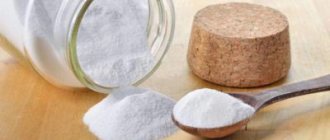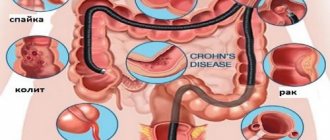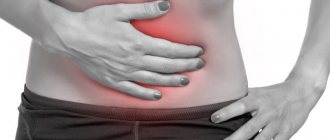In the first months of life, the baby's digestive tract undergoes a number of changes, which can cause colic. Mothers are worried about their children and ask how to help their child with colic.
so that everything is in order with the tummy. We will discuss the problem of infant colic in detail with the pediatrician of the Mother and Child clinic on Savelovskaya, Candidate of Medical Sciences Alla Anatolyevna Shcherbakova.
— Alla Anatolyevna, mothers are often worried about the issue of infant colic. What is colic in a child and how does it manifest itself?
— Colic is a behavioral disorder in a child associated with abdominal pain caused by gas formation in the large intestine during feeding. When a baby is born, his microbiotic status changes
: opportunistic microorganisms in the child’s intestines produce gases, and these gases, passing through the intestines, cause discomfort.
Typically, colic manifests itself like this: the mother begins to feed the baby, the baby eats, worries, throws the breast or bottle, cries, twists his legs or presses them to his stomach.
— Is colic normal?
— Intestinal colic is considered normal
and relate to the body’s protective reaction - “physiological inflammation”, which is formed in response to the transition from intrauterine to other nutrition (mother’s milk or formula).
— When does colic begin in newborn babies, how long does it last and when does it end?
- There are also babies who do not experience colic at all. But most often the onset of colic occurs at two to six weeks of age. Colic usually lasts up to three months
, however, there are children who experience colic before six months. Although this is more the exception than the rule.
— How to understand that a child has colic, and how to distinguish intestinal colic from other causes of baby anxiety and crying?
— The answer to this question can take an entire pediatric appointment. Colic most often occurs in the evening
and are associated with feeding: that is, the baby began to eat and began to cry. Usually the attack lasts about three hours, the tummy may be round and swollen. If the baby is gaining weight and everything is fine with his general condition, then with some degree of probability we can say that everything is fine with him.
But it also happens that a child cries, for example, due to increased intracranial pressure or some problem with the digestive organs. Therefore, only a doctor during an appointment can reliably determine the cause of a baby’s restless behavior.
During the training process, doctors are allowed to listen to a recording of infant cries during colic, so that each specialist can feel the unpleasantness of such a moment.
— When is colic more common - when breastfed or bottle-fed?
— It is difficult to unambiguously establish a direct connection between the frequency of colic and the type of feeding. Considering that mother's milk is unsterile, and the composition of modern milk formulas promotes digestion, we can say that the likelihood of colic occurring is approximately the same.
Causes of colic in a newborn
— If colic occurs equally often on breastfeeding and bottle feeding, then what are the reasons for its occurrence?
— There may be several reasons, the main ones include:
- Transient lactase deficiency.
- During breastfeeding and mixed feeding, the cause of colic may be improper attachment of the baby to the breast.
- Incorrect bottle feeding can cause colic.
- Improper nutrition of a nursing mother can also cause colic.
- Incorrectly selected milk formula.
- The psychological and physical climate plays a big role in the nutrition of infants.
The carbohydrate lactose is an essential component of breast milk or infant formula, which is involved in the formation of the brain. To better break it down, an enzyme called lactase is needed. The first months of life are an important period of maturation of the child’s body, and at this time the baby’s pancreas produces an insufficient amount of lactase
(or its low activity is noted). In turn, its deficiency leads to difficulties with the breakdown of lactose.
Thus, transient lactase deficiency occurs (that is, temporary, passing deficiency of the enzyme), causing colic. There are different opinions about lactose-free formulas, but you should not exclude lactose from your baby’s diet.
, since this is not a panacea for colic, but lactase deficiency is a temporary and fleeting phenomenon.
It often happens that mothers at an appointment ask to show how to properly put a baby to the breast and how to feed him. We explain that the mother needs to be in a relaxed state, take a comfortable position and make sure that the baby grasps the nipple with the areola and does not swallow air. Babies who suck voraciously are at a particularly high risk of colic: they may swallow air.
which enters the intestines. There it “turns” into gas bubbles, causing colic.
All modern bottles are equipped with a valve that releases excess air. There are also “anti-colic” bottles with anatomically shaped nipples that follow the contours of a woman’s nipple. A comfortable and physiological grip on the nipple minimizes the likelihood of the baby systematically swallowing air during feeding.
Many researchers associate the occurrence of colic in infants with food allergies.
.
Nowadays, many children are born with a predisposition to food allergies. We tell moms that the most common cause of food allergies in young children is cow's milk protein intolerance
. That is, for a mother who is breastfeeding and who has a family history of food allergies, it is better to limit or completely eliminate products containing cow’s milk protein from her diet, since this causes food allergies in the child, and colic in such a case is a manifestation of food allergies. allergies.
If we talk about non-dairy products in a mother’s diet, then we can note the widespread opinion about legumes. In fact, legumes can affect the mother's bloating, but if she tolerates such foods well, then she can eat pea soup and other dishes - this will not affect the baby's colic.
Feeding a bottle-fed baby helps control colic. For example, cow's milk protein intolerance may be accompanied by colic.
. In this case, the cow's milk formula will most likely need to be changed.
The main thing is to provide the baby with a favorable environment during feeding, with direct contact between the nursing woman and the child. It is important that the mother looks at the baby, and he looks at the mother, and that nothing distracts them. When parents ask whether a cat, loud noises or bright lights can cause colic, the answer is of course not. However, external bright stimuli can provoke colic.
: create a nervous environment around the baby and lead to aerophagia.
Aerophagia is the swallowing of large amounts of air during feeding.
How to help baby with colic
— Please tell us about nutritional correction if the baby is breastfed.
— We talked about cow’s milk intolerance earlier. In general, the nutrition of a nursing mother should be varied, complete and sufficient. Mom does not need to eat for two, because she will quickly gain excess weight and have difficulty returning to normal after breastfeeding. At the same time, mother should not starve. Vegetables, fruits, berries, olive oil, meat, fish - the diet of a nursing mother should meet her daily needs. If an older child has a food allergy, you need to be careful about your diet when feeding your younger one: try a little food and observe the baby’s reaction.
— What to do with colic with food if the baby is mixed or bottle-fed?
— When selecting infant formula, the doctor is guided by an examination and the condition of the child. The most important indicator of any formula is compliance with the composition of mother’s milk
. Manufacturers add prebiotics and probiotics, iron, calcium, lutein and other ingredients to infant formula to make it as close as possible to the composition of breast milk.
Artificial feeding is when the baby eats only formula. Mixed feeding or supplementary feeding - when the mother does not have enough milk and partial nutrition is used (the baby is supplemented with infant formula).
— Is it possible to give goat milk formula for colic?
— It is impossible to determine in advance how a child will tolerate this or that milk. Approximately 9% of children do not digest cow's milk
, but they tolerate goat well.
With the help of the mixture, manufacturers try to make the child’s digestion as easy as possible. But for the mixture to become an effective assistant, it must be selected with a doctor. A mixture for comfortable digestion
goat 's milk, which has a beneficial effect on the formation of soft stools, for example, MAMAKO® Premium*, can cope with colic. These are mixtures for feeding healthy children, which provide comfortable digestion and prevention of functional disorders of the gastrointestinal tract, including colic.
Colic and gas: what's the difference?
Gases in infants: symptoms and solution to the problem
Infant flatulence is a completely normal phenomenon, which is caused by the formation of the infant’s digestive system. Every day the baby eats more and more milk or formula, and the intestines do not have time to cope with it. Undigested food remains settle on its walls. They begin to ferment, and air bubbles accumulate in the baby’s gastrointestinal tract.
If the baby is tormented by gas, his tummy swells and becomes hard to the touch. The child farts often and may become capricious because of this, more often during feeding. Sometimes the baby becomes constipated due to gas. There are no other symptoms of childhood flatulence. This is how it differs from infant colic, during which the child behaves completely differently.
If your baby is suffering from gas emissions, you can alleviate his condition in the following ways:
- Make sure that the baby does not swallow excess air during feeding. If you are breastfeeding, your baby should wrap his lips tightly around the entire nipple and areola. If your baby is on IV, hold the bottle at an angle of 45°C and do not shake the formula when preparing it.
- After the baby has eaten, he needs to be held in a column for about 10 minutes so that he can burp out excess air.
- The baby should suck the breast or bottle steadily. Too fast or slow sucking leads to the fact that the baby begins to swallow excess air.
- Half an hour after each feeding, do gymnastics with the baby: press his legs to his stomach, and then straighten.
- If you are breastfeeding, exclude fresh onions, cabbage, legumes, chocolate, yeast dough and carbonated drinks from your diet. Give your child Koli Krokodil drops. They contain dill, which relieves bloating, breaks down gases and helps them exit the body more easily.
Colic in infants: symptoms and solution to the problem
Infant colic begins in the second week of life and ends when the baby is 12-16 weeks old. During attacks of colic, the baby begins to scream deafeningly. Colic crying lasts up to three hours at a time and repeats every day at approximately the same time, usually in the evenings. When a child starts crying, it is impossible to calm him down. During attacks, the baby strains, blushes, clenches his fists, pulls his legs towards his stomach, and arches his back. This condition is very unpleasant, although it is not a disease. Colic torments the baby due to the imperfection of his nervous and digestive systems. As soon as the child grows up, his attacks will stop.
Important!
Gas can cause colic. Air bubbles press on the intestinal walls. Spasms begin, which cause discomfort to the baby and make him cry inconsolably. Colic can bother a baby not only due to flatulence, but also due to increased excitability, acid reflux or dysbiosis.
It will not be possible to completely rid your baby of colic, but you can alleviate his condition now:
- Give your child a belly massage regularly. To do this, place it on its back and move your palm clockwise around the navel several times, pressing slightly.
- Apply a heating pad with warm water to your baby's belly.
- Place your baby face down on your stomach (skin to skin) to help him calm down.
- Turn on white noise for your baby (sounds of a vacuum cleaner, washing machine, hair dryer or audio recording with nature sounds).
- In the evenings, bathe your baby in warm baths with a decoction of chamomile or string. Start giving your child Koli Krokodil anti-colic drops. Their natural composition comprehensively solves the problem of infant colic: dill eliminates gas formation, lemon balm calms the nervous system, anise relieves spasms, mint improves digestion. Within ten minutes after taking the drops, the baby will feel better and fall asleep sweetly.
Prevention of colic in a newborn
— You told me how to help with colic. How to prevent their occurrence, what serves as prevention?
— There are several methods to prevent this problem.
- To reduce the likelihood of colic, apply your baby to the breast correctly
. After feeding, be sure to keep the baby in an upright position for some time, in a “column” position, stroking the back - then the air will not go further into the digestive system and will not lead to colic. - While breastfeeding, women often ask about coffee and carbonated drinks, legumes, seafood, grapes and sauerkraut - foods that can cause flatulence. If the mother tolerates such dishes well, then she can eat and drink them to satisfy her desire, but little by little. This will not affect the baby's colic in any way. But the emotional state is transmitted to the baby. A well-fed and satisfied mother means a happy baby without colic!
- If the baby is an artificial baby, then choose a bottle for him that has an “anti-colic effect
,” that is, it prevents him from swallowing air. - If your baby has colic, behave calmly
, calm and caress the baby. Distract him in any possible way, for example, talk to the baby, changing intonations, sing a lullaby, use a rattle or melodic bells, show spinning toys.
— Alla Anatolyevna, why are there no guarantees even if all recommendations are followed?
“If a mother has slept well, eaten well, walked with her child in the fresh air and armed herself with knowledge, then she calmly perceives the situation. For her, colic is a physiological and passing norm, which can be corrected by various available methods.
Medical recommendations can make colic easier and help reduce the occurrence of colic. And the best preventative complex is mother’s hands and affection. You just need to wait out this period!
Tummy pain and inconsolable crying of a baby can be caused by various problems, including gastrointestinal ones. Discuss your baby's restless condition with your doctor, as there are pathologies that may only appear to be colic. During colic attacks, the main task is to calm the baby as much as possible using available methods. But you should not give your child medications, herbal remedies or other sedatives without first consulting your pediatrician. Almost all children go through a period of infant colic, and, fortunately, they disappear with age as suddenly as they begin.
Candidate of Medical Sciences, pediatrician Alla Anatolyevna Shcherbakova
*The ideal food for an infant is mother's milk. WHO recommends exclusive breastfeeding for the first 6 months. MAMAKO® supports this recommendation. Before introducing new foods into your baby’s diet, consult a specialist.
Colic during artificial feeding

Colic during artificial feeding occurs due to early transfer to formula and improper selection of nutrition. They are manifested by spasmodic pain in the abdomen, deterioration of the child’s general condition, severe anxiety, screaming, increased gas production, and crooked legs.
- The concept of colic, causes
- Colic from malnutrition
- Symptoms of colic
- Diagnostic measures
- How to help your baby during a colic attack
- How to avoid colic
The concept of colic, causes
Colic in infants persists until 3-4-6 months of age. After 6 months they gradually fade away. During an attack, the child's intestines contract.
In children, spasm of the intestinal muscles occurs not in one section of the intestine, but throughout the small and large intestines. This causes severe abdominal pain.
Infant cramps occur for the following reasons:
- abnormal intestinal development: megacolon and others;
- tumors, polyps of the digestive tract;
- immaturity of the intestinal muscles;
- lack of enzymes;
- intestinal dysbiosis;
- intolerance to certain proteins, allergies;
- poor nutrition.
Also, intestinal spasm appears in premature babies, children who have suffered hypoxia during pregnancy and childbirth, and patients with lactase deficiency.
Colic from malnutrition
Nutrition for a baby is of great importance.
Intestinal pain is provoked by:
- Incorrect position of the bottle, which causes a large intake of air into the stomach.
- Force feeding.
- Insufficient dilution of the mixture, which leaves undissolved particles.
- Lack of semi-upright position after eating.
In addition, pain is often provoked by an early transition to artificial feeding.
Feeding with formula in the first weeks of life especially affects the state of the digestive tract.
It contains virtually no digestive enzymes that improve the absorption of nutrients. Therefore, it is recommended to delay the introduction of artificial nutrition as much as possible in the first month of life.
Against the background of early introduction of the mixture, the biocenosis of the intestine is disrupted. The number of digestive bacteria decreases, pathogenic microorganisms multiply. With a deficiency of normal microflora, food absorption deteriorates.
Undigested remains of the digestive bolus cause bloating. The walls of the intestine are stretched, spasm and pain occur.
Incorrect selection of mixtures also provokes dysbiosis and bloating. Therefore, it is necessary to take a serious approach to choosing food for your baby.
Frequent changes of mixtures are not allowed.
Artificial nutrition is very satisfying. It contains a high concentration of proteins, which increase the density of stool. Diluting too concentrated a mixture causes constipation.
Because of this, the digestive masses stagnate, bloating and stretching of the intestinal walls occurs, which also leads to pain.
Colic also appears with the early introduction of complementary foods. If you give your baby food that is not appropriate for his age, it will be poorly digested. Against this background, the baby develops abdominal pain and increased gas formation.
It is unacceptable to introduce several products at the same time. This will have a bad effect on the functioning of the digestive tract and cause allergies, which is also accompanied by bloating.
Incorrect feeding technique directly affects the child's condition. Increased swallowing of air increases pain.
After feeding, be sure to keep the baby in a semi-upright position.
Symptoms of colic
The symptoms of the condition do not have specific manifestations. The baby experiences severe pain during intestinal spasms. An attack of pain occurs suddenly.
At the same time, the baby's hands are pressed to the stomach, the legs are cold. He cries a lot and kicks his legs. The anterior abdominal wall is tense.
Useful tips for mothers: BABY HEALTH
Infantile intestinal pain is accompanied by bloating. The child has an increase in abdominal volume.
When palpated, the baby feels pain and crying intensifies. Rare regurgitation is possible.
Symptoms intensify during feeding or after 10-15 minutes. Formula-fed infants often experience constipation, which causes cramping, especially during or after meals.
Depending on the severity of clinical manifestations, there are several degrees of pain severity:
- mild – moderate pain, crying up to 1 hour per day;
- medium – more severe pain, crying up to 2–3 hours a day;
- severe - the duration of the attack is more than 3 hours per day.
The severity determines the treatment tactics.
Diagnostic measures
Diagnosis of the condition is carried out using a “crying diary”. The mother records the duration of the attacks, the time of bowel movements and meals per day.
The diagnosis of infant colic is made only in the absence of other diseases that provoke intestinal spasms.
To exclude them, carry out:
- ultrasound examination of the intestine;
- general tests of stool, blood, urine;
- feces for dysbacteriosis and other methods.
The list of examinations is prescribed depending on the accompanying symptoms and medical history.
How to help your baby during a colic attack
Therapy for intestinal pain syndrome is aimed at relieving spasms, reducing gas formation in an infant, and relieving maternal stress. The woman is explained that this is not a pathological, but a normal condition.
To reduce the symptoms of intestinal manifestations, it is necessary to feed the baby properly. The mixture is given to the child in a bottle. It is tilted at an angle of 45ᵒ so that the air rises to the bottom.
It is better to purchase nipples for bottles with an anti-colic system. They have a special hole that prevents air from being swallowed during feeding.
After eating, the baby is kept in a semi-vertical position at an angle of 45ᵒ for 10-15 minutes. During an attack of colic, the baby is placed on his stomach between feedings. Tactile contact between the skin of the baby's abdomen and the mother is also welcome.
A warm bath and a clockwise abdominal massage relieve pain well.
If this does not help, use a gas tube and do an enema.
If these measures are ineffective, the baby is prescribed simethicone. They collapse air bubbles, reducing bloating. The drug Plantex is also used.
It contains lactose, essential oils, fennel fruits, due to which spasm and bloating go away. The drug Plantex is actively prescribed for lactase deficiency.
How to avoid colic
Prevention of intestinal cramps begins during pregnancy. The mother should eat properly and avoid stress. At the slightest threat of miscarriage, contact a gynecologist to eliminate spasms of the uterine muscles, as they increase hypoxia.
To prevent the occurrence of intestinal cramps after the birth of a baby, it is necessary to switch to artificial feeding as soon as possible.
It is recommended to follow feeding technique to avoid swallowing air. Choose the mixture carefully. Do not allow early introduction of complementary foods, since a baby up to 4 months of age is not yet ready for new food.
Infant colic in the absence of concomitant diseases is a normal condition for a baby. They pass by 6 months of life.
If severe pain occurs, contact a pediatrician for diagnosis and treatment of the condition.
- about the author
- Recent publications
Olga Kuznetsova
author of the publication (site editor)
DOCTOR - PEDIATRIC Education: Siberian State Medical University. Certificate of specialist in the specialty "Pediatrics"
Olga Kuznetsova recently published (see all)
- Suprastin during breastfeeding - 07/14/2020
- Child growth by months - 07/08/2020
- How to rinse a newborn's nose - 07/05/2020
Reviews #MAMAKO
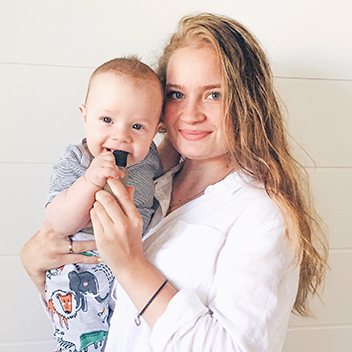
kanstansiya
Why do mothers choose adapted MAMAKO® Premium formulas? The story of how Savely overcame colic. Mothers whose babies are completely on IV are faced with some problems when choosing a formula. For Savely, choosing a mixture, as it turned out, was not an easy task. We tried many companies, but in the end we came to one - Adapted milk formula from @mamako.ru Premium with natural goat milk, its creamy taste conveys all the love of nature. We, like many, encountered bloating, gas and colic, and only a mixture with goat milk miraculously helped us forget about this terrible word - “colic”. As a mother, it is very important to me that the baby receives the most necessary vitamins for the development and growth of the child.
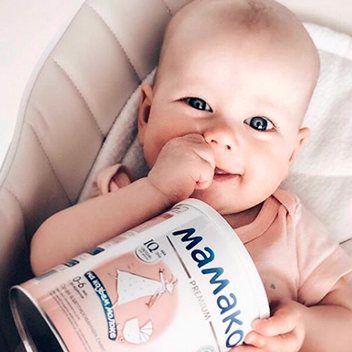
shitova_sasha
It so happened that I need to heal a little. Perhaps someday I will talk about this and urge everyone to take care of themselves, but that’s not what I’m talking about right now. Although our IV is temporary, I approached the issue of choosing a mixture thoroughly. Now we eat the @mamako.ru mixture, which is produced on the basis of goat milk in Spain. Why did I choose a mixture with goat milk? Firstly, it has a different composition of proteins than cow milk. Therefore, if a child is intolerant to cow's milk, then a goat's milk formula may be suitable for him (exactly our case). BUT! If you have allergies, you should always consult your pediatrician! Secondly, precisely due to the properties of goat’s milk, soft, curdled flakes are formed in the baby’s stomach, which are easier to digest.
